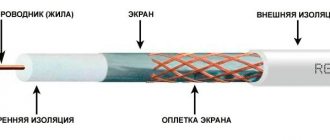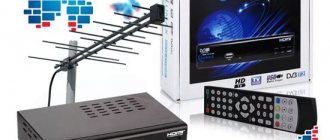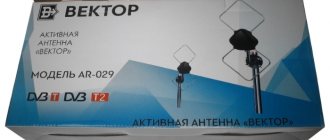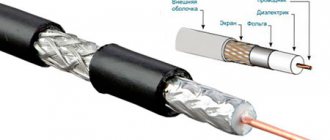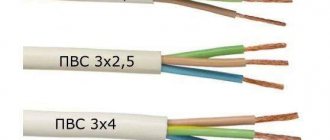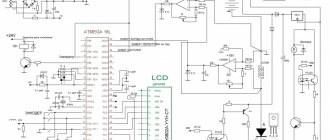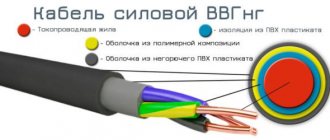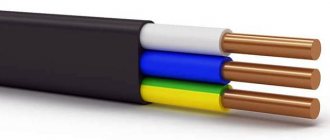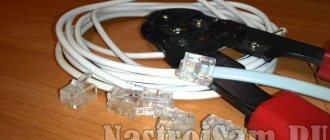Content:
- 1 Definition of electrical cable
- 2 Structure of the television conductor
- 3 Marking
- 4 What to look for when selecting a cable? 4.1 Protective layer material
- 4.2 Mechanical strength
- 4.3 Screen Features
- 4.4 Cable length and thickness
- 4.5 Outer shell
- 4.6 Central core
- 4.7 Manufacturer
- 4.8 Dielectric layer
When choosing a coaxial cable for a TV, you will notice that various types and brands of cable products are offered for sale to customers. Before purchasing coaxial wire, it is recommended that you familiarize yourself with the characteristics and differences between different product models, as well as the characteristics of its design.
How to choose
When making a choice, you should keep in mind that the price of an antenna cable for a TV may depend on many factors, namely:
- who made it (naturally, well-known brands such as Sparks or Vivanco will cost more than Chinese products);
- brand. The design depends on this, in particular, how many cores are in the conductor screen, the number of screens, the material of the central conductor, etc.
It should be taken into account that the specificity of high-frequency current is that it flows along the surface of the conductors, which is why the characteristics of a cable with a copper core and a steel one (copper-plated) will be almost identical. But, if copper wire is used, the cost will be significantly more expensive, this should be taken into account when purchasing.
For general information, we note that in high-precision equipment the conductors are coated with silver or gold plating; using this type of cable product to connect a TV to an antenna would be an unaffordable waste.
It is necessary to pay attention to the diameter, it must be at least 6 mm thick. Of course, a thin cable will be much easier to install in an apartment, but standard connectors and sockets in this case will be problematic to use.
When planning to buy the required amount of antenna cable, take into account that it is usually sold in coils of 100 meters (twisted in rings); not every seller will agree to sell it in parts.
It makes no sense to give an estimated cost for the regions of Russia and the CIS countries, since the spread of prices in Moscow, Minsk, St. Petersburg, and other cities is insignificant.
Electrical cable definition
Coaxial (coaxial cable) is a telecommunications element that allows you to simultaneously broadcast a certain number of high-frequency signals with minimal losses. Its operation is based on the potential difference that appears in the presence of two different metal conductors, separated from each other by means of a guide insulating layer. Why is coaxial cable needed?
Insulated cores are used in devices that transmit industrial and satellite television signals in automatic and alarm systems or computer networks.
TV conductor structure
Getting acquainted with the structural properties of the cable for a TV, you will notice that all models provide for a similar systematization of the internal element:
- Coaxial is a conductor that affects signal transmission. It is made from copper tube, solid wire or stranded material. The quality of the raw materials influences the permissible bending coefficients and the signal.
- Dielectric is a plastic layer that acts as a conductor retainer.
- Metallized thickness is a combination of polyester with copper or aluminum.
- The metal braid is made of foil and thin wire. The more complete its weave, the better the quality of the cable and the degree of protection from external influences (radiation, moisture).
- The outer casing protects all structural components of the electrical wire.
The differences between the products lie mainly in the characteristics of the material used.
When solving the problem of which television cable is better to choose, you need to decide on your goals. For example, if the signal distance is minimal, it is not recommended to overpay for an expensive cable.
Design
A distinctive feature of the antenna cable design is the radial arrangement of all elements relative to the central axis. Due to the coaxial arrangement of cylindrical shapes, such a conductor element for signal transmission is also called a coaxial cable. If we consider the design of a typical antenna cable, it includes:
Rice. 1. Antenna cable arrangement
- The central conductive core is usually represented by copper or bimetallic steel-copper wire. Structurally, the central core can be made monolithic or structured. Depending on the cross-section of the core, the degree of signal attenuation in the cable is determined.
- Internal dielectric - located radially around the current-carrying core. It can also be made from various materials, the highest quality of which is considered to be foamed polyethylene.
- Wire braid screen is a multi-wire structure, usually made of copper or aluminum wire. Designed to capture electromagnetic interference. Depending on the filling density, it is divided into 96%, 75%, 64%.
- A foil screen - like the previous option, is used to protect against electromagnetic influence. It is made with solid aluminum foil, twisted tape, tightly laid on the cylinder of the internal dielectric.
- External insulation layer - designed to protect the braid, shielding layer and current-carrying conductors from mechanical damage, exposure to aggressive environments and weather factors. Depending on the material from which the outer layer of the antenna cable is made, it can be used for installation indoors, on an open part of the building, under direct exposure to sunlight, etc.
The design of the antenna cable is determined individually for each specific model, so it may not contain some components or may differ in composition. Therefore, when choosing a specific brand of coaxial conductor products, it is important to familiarize yourself with the presented brands and their technical parameters.
Marking
Laying and connecting a coaxial antenna cable does not require any special skills or knowledge in this area. It is much more difficult to choose an electrical cable taking into account the specifics of television transmission of information. To understand which option is better to buy, it is recommended to consider the labeling and initial data of the products.
Coaxial cable brands:
TV repairs are 30% cheaper
than in service centers near your home
Order repairs
- RG – 6 has gained popularity due to its low price and good properties. Suitable for interior work.
- RG-59, a thin cable that receives all types of signals, loses its characteristics at a distance of more than 190 m.
- PK 75 from the Russian manufacturer provides a copper core and braid, as well as a double protective stage made of tinned copper and aluminum.
- The SAT 703 brand has a characteristic impedance of 75 Ohms, as well as a double screen.
- SAT 50 from the Italian brand has an enhanced degree of protection.
- DG 113 is the most expensive antenna coaxial cable, but increased shielding values transmit high-level signals.
Optimal solution
As an optimal option, we can recommend the middle price segment (SAT 50, SAT 703). Such conductors have a fairly high quality of performance and good performance in signal transmission.
Budget models (RG-6, RK 75, RG 59) are suitable for laying lines over short distances under normal conditions. More expensive models (DG 113) are used where it is necessary to ensure the best signal quality and maximum protection.
What to look for when selecting a cable?
Before you go to the store, you should figure out which antenna cable for your TV is best to buy. First, it is recommended to find out the following parameters:
- number and type of connected television equipment;
- location of the signal resource - loggia or roof;
- what space is intended for laying - an apartment or a large country house;
- terms of Use;
- format of the stored signal – type of broadcasting (analog or digital);
- total length of the network.
For high-quality signal reception, each TV antenna cable must have a resistance coefficient of less than 75 ohms.
Protective layer material
To increase strength, additives are added to plastic to reduce the negative impact of atmospheric factors. This TV cable is more expensive and is intended for laying external lines. Indoors, it is better to use cheap types of low-current cables.
Important: Some product manufacturers produce polymer layers from recycled materials. As a result, the cost of products decreases, and the profit of the enterprise increases.
Recyclable materials are obtained after processing various wastes. As a result of prolonged use, they lose their original characteristics, have low mechanical strength and are susceptible to ultraviolet radiation.
Distance from signal source to consumer
Signal leakage in the conductors occurs despite the reduced resistance. The longer the distance, the larger they are. It is recommended to reduce the negative impact by increasing the cross-section. The further the television panel is located from the internal electrical wiring or antenna, the thicker the TV wire will be needed.
Important: For extremely large diameters, specific adapters should be selected to connect consumers and lines.
Mechanical strength
To check the strength of polyethylene, you need to lean the element against the tensile load segment, and 2-3 times. bend and unbend the wire. If it is clear that the polymer has quickly cracked or stretched out, then it is not advisable to buy cable products.
Screen Features
It is recommended to buy an antenna cable for digital television with at least 2 shielding layers. This factor protects the signal from the influence of an external field (electromagnetic or magnetic). Modern versions of cable products include a layer of foil and a special winding made of thinner wire.
Cable length and thickness
These parameters will allow a non-professional person to learn about the technical features of the electrical wire. Thin coaxial cable is easier to lay and hide in a box. But at the same time there will be comments on the quality of the transmission. At home, conductive conductors with a cross-section of at least 3.5 mm are used.
If we consider the length of the conductor, then to prevent problems with installation it is necessary to have an electrical cable with a reserve. It will come in handy if some area is damaged during work and needs to be replaced. The second factor is rearranging the furniture. It is possible that the television panel will be moved, and this will require a longer coaxial cable.
The choice of electrical cable involves determining the length of the network. The longer it is, the thicker the cable you need to choose.
Outer shell
There are models in black and white. Dark products are covered with a polyvinyl chloride shell, and light ones are covered with polyethylene film. For street wiring, only black wire was used, but nowadays white SAT 703 brand is often chosen. This universal option is suitable for installation both outside and inside. It is also necessary to take into account the thickness of the outer coating. The larger it is, the more reliable and secure the connection will be. At the same time, the flexibility of the structure is significantly reduced and the bending radius is limited.
Central vein
The channel core is made primarily of copper or other durable metal alloys. The option with a copper core is considered the most reliable and resistant to damage. Its thickness is also taken into account; this indicator ranges from 0.3-1 mm.
Manufacturer
The electrical accessories market offers customers a wide range of antenna wires for TVs. This affects manufacturers and technical features of products. Experts advise purchasing products from well-known brands, which have many advantages.
Experts suggest focusing on offers from the following companies:
- Mediaflex;
- Cavel;
- commscope;
- Belden.
The manufacturer is not considered the main factor when purchasing. First, the technical criteria of the television cable are determined.
Dielectric layer
The interlayer serves to fix the conductor and insulation. For these purposes, foamed polyvinyl chloride is used. There are also polyethylene, fluoroplastic options made of polyethylene or an air shell.
TV cable
answer the questions of which television cable is better and how to choose an antenna cable for a TV . You should find out the specific operating conditions and the devices connected to it. It is also important to know the source of the television signal - terrestrial or satellite antenna, the climatic conditions of the cable, the total length of the installation, the number of connected TVs, the presence of powerful sources of electrical interference, the diameter of the outer insulating layer and even the color of the television cable should be taken into account when ordering.
- Diameter - a television antenna cable with a smaller diameter is easier to lay around the apartment, mask, and has a smaller bending radius. But in all other characteristics it loses, and most importantly, it has not only a smaller overall size, but also a smaller central core diameter: 0.5 mm. Therefore, the connection and connection of such a cable will not be good in standard connectors and splitters designed for a center conductor diameter of 1 mm.
- Shielding - A modern television cable has a main metal foil shield and an additional metal braided shield, which reduce the level of interference from sources such as electric motors and transformers of household appliances, and radiotelephones. Replacing an old single-screen cable with a dual-screen cable often improves picture quality: ripples from interference on the TV screen disappear.
- Protective carbon layer - the presence of a protective carbon layer in the television cable implies its connection outdoors. Operating conditions, whether the product will experience temperature changes from + 40 in the summer to - 30 in the winter, determine the service life.
- The composition of the central core and braid - it is believed that a television wire with a copper central core is better. This opinion is not always true. A cable with a copper core is used in the installation of satellite systems, where direct current flows through the central core, together with the high-frequency television signal, to power the converter. In the case of cable and terrestrial television, the radio frequency signal - that is, essentially high-frequency currents - flows exclusively along the surface of the conductor. Thus, when transmitting antenna signals, a cable with a copper-plated steel core will not lose in attenuation characteristics.
- The length of the television cable is the total attenuation of the signal, that is, the decrease in the level of the television signal, is a multiple of its total length, and when laid inside an apartment, when about 30 meters are spent through a splitter, it has no practical significance.
- Color marking of a television cable - there is an opinion that the color of the outer insulation, or the stripes applied to it, can indicate its quality. It is believed that black cable is intended for outdoor use, and white cable is intended for indoor installation, that longitudinal color stripes indicate its quality, and green is the best. However, the properties can only be judged by the technical characteristics, in which there is no color marking. The choice of color depends on the preferences of the buyer, and the presence of stripes of different colors on the cables simplifies the installation of cable systems with many wires.
REXANT TV cable marking
REXANT brand products appeared on the Russian market not so long ago. The company's production facilities are located in China. TV cables, as well as F-connectors, plugs, lugs, and adapters produced by REXANT are in mass demand due to their good price-quality ratio.
television cable is produced by REXANT. The most widely used types of television coaxial cables are: RG-6U+CU; RG-6U; RG-59; RG-59+CU; 3C-2V and RG-58A/L.
REXANT RG-6U+CU
wave impedance 75 Ohm, consists of a coaxially placed central single-core copper conductor with a diameter of 1 mm; screen consisting of aluminum foil and 48 copper threads. The internal solid conductor is made of copper, which allows simultaneous transmission of high frequency and direct current signals with minimal loss, and is enclosed in a polyethylene dielectric that maintains the coaxial location of the conductor and shield. The outer sheath of the cable is made of PVC and has a diameter of 6.8 mm, which ensures reliable fastening of the F-connector to it. The REXANT RG-6U+CU antenna cable is suitable for transmitting signals from satellite and terrestrial antennas, as well as cable television signals.
REXANT RG-6U
wave impedance 75 Ohm, consists of a coaxially placed central single-core copper-plated steel conductor with a diameter of 1 mm; screen consisting of aluminum foil and 48 steel threads. The internal solid conductor is made of copper-plated steel, which provides high-frequency signal transmission with minimal loss, but is not intended for direct current transmission, and is enclosed in a polyethylene dielectric that maintains the coaxial location of the conductor and shield. The outer shell of the television cable is made of PVC and has a diameter of 6.8 mm, which ensures reliable fastening of the F-connector to it. The REXANT RG-6U antenna cable is suitable for transmitting signals from over-the-air antennas, as well as cable television signals.
REXANT RG-59+CU
characteristic impedance 75 Ohm, consists of a coaxially placed central single-core copper conductor with a diameter of 0.58 mm; screen consisting of aluminum foil and 48 copper threads. The internal solid conductor is made of copper, allowing simultaneous transmission of high frequency and direct current signals with minimal loss, and is enclosed in a polyethylene dielectric that maintains the coaxial location of the conductor and shield. The outer sheath of the cable is made of PVC and has a diameter of 5.4 mm, which ensures reliable fastening of the RG-59 F-connector for 5 mm cable. The REXANT RG-59+CU antenna cable is suitable for transmitting signals from satellite and terrestrial antennas, as well as cable television signals over short distances.
REXANT RG-59
characteristic impedance 75 Ohm, consists of a coaxially placed central single-core copper-plated steel conductor with a diameter of 0.5 mm; screen consisting of aluminum foil and 32 steel threads. The internal single-core conductor is enclosed in a polyethylene dielectric, which maintains the coaxial location of the conductor and the screen. The outer shell of the television cable is made of PVC and has a diameter of 6 mm, which ensures reliable fastening of the RG-59 F-connector for a 5 mm cable. The REXANT RG-59 antenna cable is suitable for transmitting signals from over-the-air television antennas, as well as cable television signals over short distances.
REXANT 3C-2V
wave impedance 75 Ohm, consists of a coaxially placed central single-core copper-plated steel conductor with a diameter of 0.5 mm; screen consisting of aluminum foil and 32 steel threads. The internal solid conductor is made of copper-plated steel, providing high-frequency signal transmission, and is enclosed in a 3 mm diameter FPE polyethylene dielectric, which maintains the coaxial location of the conductor and shield. The outer shell is made of PVC and has a diameter of 5 mm, which ensures reliable fastening of the RG-58 F-connector on it. The REXANT 3C2V antenna cable is suitable for transmitting signals from over-the-air antennas, as well as cable television signals over short distances.
REXANT RG-58A/L
wave impedance 50 Ohms, consists of a coaxially placed central stranded conductor consisting of 19 copper conductors with a diameter of 0.12 mm; screen consisting of aluminum foil and 48 copper threads. The outer shell is made of PVC and has a diameter of 5 mm. The REXANT RG-58A/L cable is designed for transmitting video signals from surveillance cameras or other sources. Use as an antenna is possible over short distances. For a high-quality connection of F-connectors with plugs and adapters, it is necessary to tin the protruding end of the central stranded wire with solder.
Recommendations for use
To ensure that your digital television cable lasts a long time, it is advisable to follow these recommendations:
- when choosing a product, you need to select brands that have good wave capacity;
- for laying electrical wires in extreme conditions and on the street, it is better to buy options with special impregnation;
- You should not lay the coaxial television cable near electrical appliances, they may interfere;
- When laying a conductor, it is necessary to make a minimum of connections and solders; a large number of them has a bad effect on the properties of the signal. A good solution is to lay a continuous shell;
- When installing and connecting the electrical wire, you must follow the manufacturer's instructions. Particular emphasis is placed on the gap between the fasteners and the bending line;
- It is better to use branded devices for branching. Electric amplifiers and splitters are placed at accessible points. If a breakdown occurs, repairs are easier to do.
Subtleties of choice
Experts have identified nuances that are important to consider when selecting a cable for digital television:
- The thickness of the electrical wires is determined by the length of the laying route. The distance from the antenna to the equipment affects the attenuation of the television signal;
- do not forget about the location of electrical wiring or utilities that create an electromagnetic environment;
- It is advisable to select a cable for the TV antenna with a double protective layer;
- if the antenna is located nearby - on a balcony or on television equipment, then a coaxial wire with a diameter of 6 mm will be sufficient. To place it on the roof of a country house or on top of a multi-story building, you need to take a size of 7 mm;
Important: a copper core is required for satellite transmission; budget variations are suitable for all other channels. In the store you need to take a good look at the cut and properties of the inner core.
What is important when choosing
The choice of cable for a TV antenna is based on 7 main factors:
- Outer shell material. In the production of feeders, two options are used - PVC and light-stabilized (that is, resistant to ultraviolet rays) polyethylene. PVC is ideal for use inside an apartment (for example, when connecting to a communal antenna or cable TV). But for external laying nothing better than polyethylene has yet been invented. An unsuitable type of coating will lead to cable damage and breakdown.
- Strength of the outer layer. It is enough to try the outer PE or PVC sheath on a section of the feeder by pulling it towards you. If it moves easily, there is no need to use the cable: bending may damage the screen.
- The length of the route along which the cable channel will pass. The longer, the greater the loss of signal power due to conductor resistance. Therefore, where you need to lay a long route (10 m or more), it is better to use a cable with a copper central core rather than a steel one;
- Incoming signal power. Reception of terrestrial relay television broadcasts of the DVB-T2 standard provides the equipment with sufficiently powerful impulses, the same applies to cable TV. But the signal strength coming from the satellite is low. Therefore, for dishes it is better to choose cables with a copper core.
- Diameter of the central core. The thicker it is, the less loss during signal transmission. However, conductors that are too thick may require special adapters in order to be used in standard connectors.
- Cable thickness. Typically, the more powerful the feeder, the more layers of shielding are used, the thicker the central core and the more reliable the insulation. However, this is only an indicative sign. A high-quality, thin cord may be better suited for installation than a thick, low-quality cord. We'll talk about this below.
- Material of the central core. Copper transmits the signal better, clad steel is stronger. It’s easy to check what the core is made of: you need to take a magnet and bring it to the cable. If there is attraction, it means steel, if there is no attraction, it means copper.
Connection method
Having selected a suitable coaxial cable, you need to make sure that your existing equipment has a special connector. Most often there are F-connectors, less often N-varieties.
Fasteners come in the form of crimp plugs or screw plugs. The simplest connection method is a plug (angled or straight). Step by step execution:
- Using a knife, cut the outer layer to a length of 15 mm and remove it. Wrap the conductor screen with foil. Remove the insulation from the core and wrap it around the plug.
- Cut the protruding main core to the required length.
- Screw the crimp circle onto the edge, cut the insulating layer to a length of 6 mm and remove it.
- Remove the layers of copper tube from the cleaned segment. These manipulations should be done with care so as not to damage the element or interfere with signal transmission.
- Place and slide the fork lengthwise until the inner fibers emerge from the middle.
- Insert the connector into the edge of the wire and secure with a crimp ring.
- Cut off protruding wires.
Coaxial cable is one of the important components of antenna installations. This factor is often overlooked and underestimated when purchasing a conductive cable for analog, satellite or digital broadcasting.
Found a mistake? Select it and press ctrl+enter
- 100
